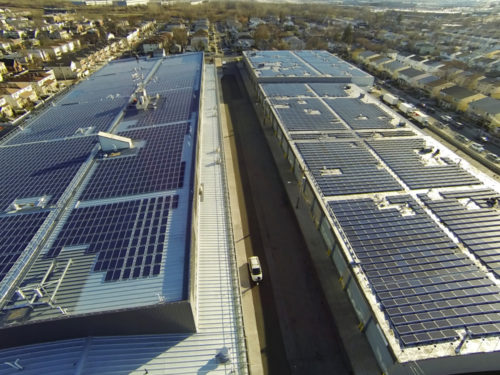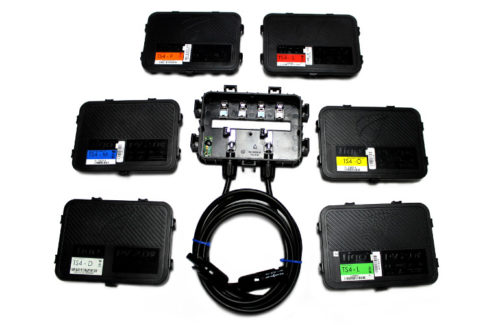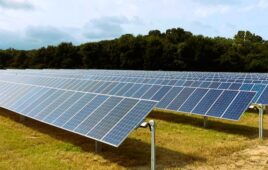By Edgar Lim, director of technology and procurement at EnterSolar
As an industry evolves, so do the codes and standards that govern the design and safety aspect of its products. The automotive industry has evolved to set minimum sound requirements for hybrid and electric vehicles to reduce the risk of pedestrian crashes, especially for the blind and visually impaired. The solar industry’s evolution is no different.
The solar market is constantly becoming more knowledgeable on arc-faults, shock hazards and emergency fire situation on rooftops. The National Electrical Code (NEC) as related to solar has evolved from just requiring arc-fault detection devices to more specific module-level shutdown requirements. In 2014, Section 690 of NEC 2014 required all conductors more than 5 ft inside a building or more than 10 ft from an array to be limited to a maximum of 30 V and 240 VA within 10 seconds of shutdown. String inverters located on a commercial rooftop within 10 ft of an array boundary would meet the requirements, as would module-level power electronics (MLPE) with built-in disconnecting functionality.
In the spirit of further reducing shock hazards for emergency responders, NEC 2017 revised the rapid shutdown requirements and reduced the array boundary from 10 ft to 3 ft. In addition, the code now includes a subsection which addresses conductors within the array boundary. This subsection provides three compliance options for reducing hazards within the boundary:
- Option 1: The PV array shall be listed or field-labeled as a rapid shutdown PV array.
- Option 2: Controlled conductors located inside the boundary or less than 3 ft from the point of penetration of the surface of the building shall be limited to no more than 80 V within 30 seconds of rapid shutdown initiation.
- Option 3: Install a nonmetallic PV array with no exposed wiring methods and have it located more than 8 ft from exposed grounded conductive parts
This section will become effective January 1, 2019. The adoption delay has allowed industry stakeholders to develop a product safety standard for rapid-shutdown PV arrays. UL has developed standards for under which solar equipment manufacturers can list their products.
As 2019 is fast approaching, stakeholders within the commercial space are racing against the clock to come up with solutions and strategies to meet the code in jurisdictions that have or will be adopting NEC 2017. Some of the questions we should ask ourselves, if we haven’t already, include material and labor cost implications, product reliability, bankability of the manufacturer and additional functionality that could benefit system operators.
Already compliant products for the residential market aren’t necessarily suited for commercial applications. Cost structures differ between the two segments of the industry, and that’s why only a subset of market-ready solutions are suited for the commercial space.
Here are some that could help meet the rapid shutdown requirements in the commercial sector:
Tigo Energy
Tigo’s Flex MLPE TS4 Platform has integrated module junction box solutions– the TS4-D, TS4-M, TS4-F, TS4-S, TS4-O and TS4-L–and retrofit/add-on solutions including TS4-R-M, TS4-R-F, TS4-R-S, TS4-R-O. The Tigo solution is inverter agnostic, however, one does need to check for compatibility to ensure interoperability. The list of inverters approved for use with Tigo’s platform can be found here.
SolarEdge Technologies
SolarEdge has an optimized inverter solution that includes module-level rapid shutdown functionality, as well as an optional firefighter gateway and an emergency stop button. The SolarEdge solution includes lifetime monitoring support as well as enhanced module-level performance monitoring. SolarEdge has retrofit versions of optimizers which cater to modules with power ratings as high as 425 W (P850). These are dual input optimizers for parallel connection of two modules.
Maxim Integrated
Maxim already has a cell-string optimizer, which is a highly integrated DC-DC converter that replaces traditional bypass diodes to reduce the impact of mismatch. The company is working on the next generation module cell-string level optimizer that will be compatible with a wide variety of inverter and modules and comply with NEC’s module-level shutdown requirements. However, it will not incorporate monitoring features to reduce complexity.
Despite the market-ready solutions available today, there is still plenty of room for innovation and new entrants into the marketplace to help commercial stakeholders meet the code requirements. New product releases that comply with new code requirements typically lag the code that warrant its development, as we’ve seen with arc-fault detection devices back when it was required by NEC 2011. However, collaborative efforts between various industry stakeholders, like the platform that SunSpec Alliance established with the Rapid Shutdown Workgroup, will expedite the process.
As of May 2018, 20 states have already completed its NEC 2017 adoption process and nine others are in the process of adoption. It would be prudent for solar installers to start thinking about their compliance strategy and factor it into their projects in development in preparation for what’s to come.
EnterSolar has been working with product developers and manufacturers to provide feedback on forward-compliant products already available based on our installation and operational experience. We have also been working with our O&M subsidiary MaxSolar to close the feedback loop and share valuable reliability and performance data with product manufacturers in the spirit of kaizen. We are engaged and committed to help the industry to be in a better position to fully comply with NEC 2017 rapid shutdown requirements come January 1, 2019 and to act in our clients’ best interest from a safety standpoint.
For more information on the types of products in compliance with NEC 2017 module-level rapid shutdown requirements, read Solar Power World’s story, “How to meet NEC 2017 rapid shutdown requirements.”






Rapid shut down at the module level should have been implemented from the day the first module was manufactured. I know of no other manufactured product that either consumes energy or produces it that doesn’t come with an on/off switch. Think about it.
Modules should be delivered,mounted and conductor connections should be done with and open circuit on the module until time commission At witch time a key could be installed the module J box that would close the circuit on the module. By using a separate key to close the module circuit reduces the risk of human error.
What in the Sam Hell are you talking about?